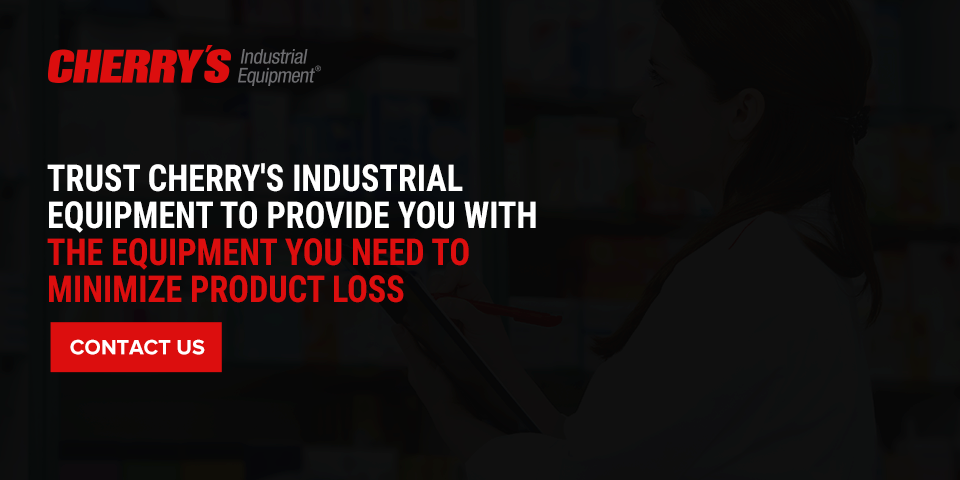Top 3 Ways to Reduce Pharmaceutical Product Loss During Cold Chain Shipping
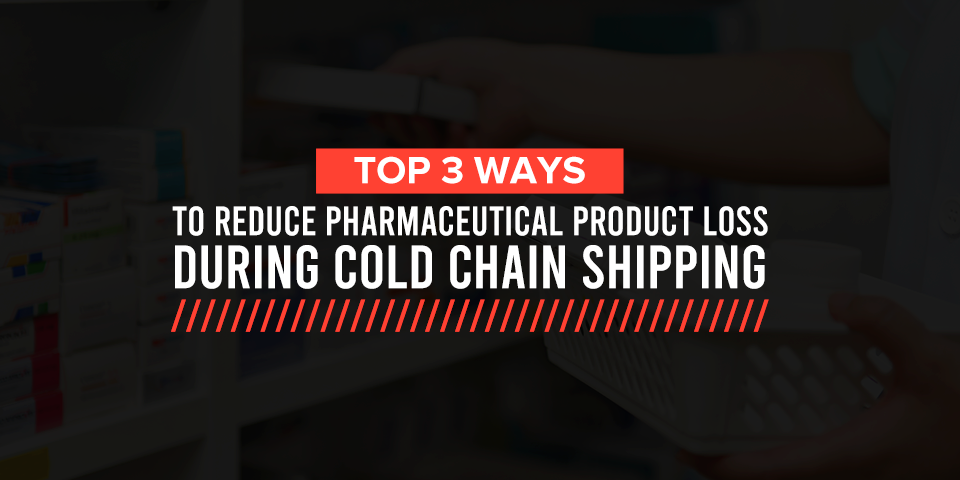
The cold chain pharmaceutical market is already at $44 billion and is growing far faster than the more traditional non-temperature-sensitive drugs market. As this is an increasingly important aspect of the overarching global pharmaceutical supply chain, it is crucial to develop a reliable cold chain shipping method that can keep drugs at the proper temperature to ensure patient safety and minimize product loss.
This article will go over the most pressing problems facing the pharmaceutical warehouse industry today, including topics like what cold chain shipping is, what the effects of product loss can be and how to transport pharmaceutical products to help mitigate cold chain shipping loss in pharmaceuticals. Keep reading to learn how to limit your pharmaceutical product loss through cold chain shipping solutions.
Jump To Sections:
- Problems Facing the Pharmaceutical Warehouse Industry
- What Is Cold Chain Shipping?
- Damages of Pharmaceutical Product Loss
- 3 Ways to Reduce Pharmaceutical Product Loss During Cold Chain Shipping
- Trust Cherry’s Industrial Equipment to Provide You With the Equipment You Need to Minimize Product Loss
Problems Facing the Pharmaceutical Warehouse Industry
As the place where pharmaceutical products are manufactured, stored and shipped, a pharmaceutical warehouse needs to be as clean, safe and efficient as possible. Because pharmaceuticals must always be delivered in peak condition, any mistakes throughout the manufacturing process could lead to great product loss. To ensure a top-quality product, pharmaceutical warehouses have to overcome various issues that threaten to disrupt or slow down their systems and cause product loss.
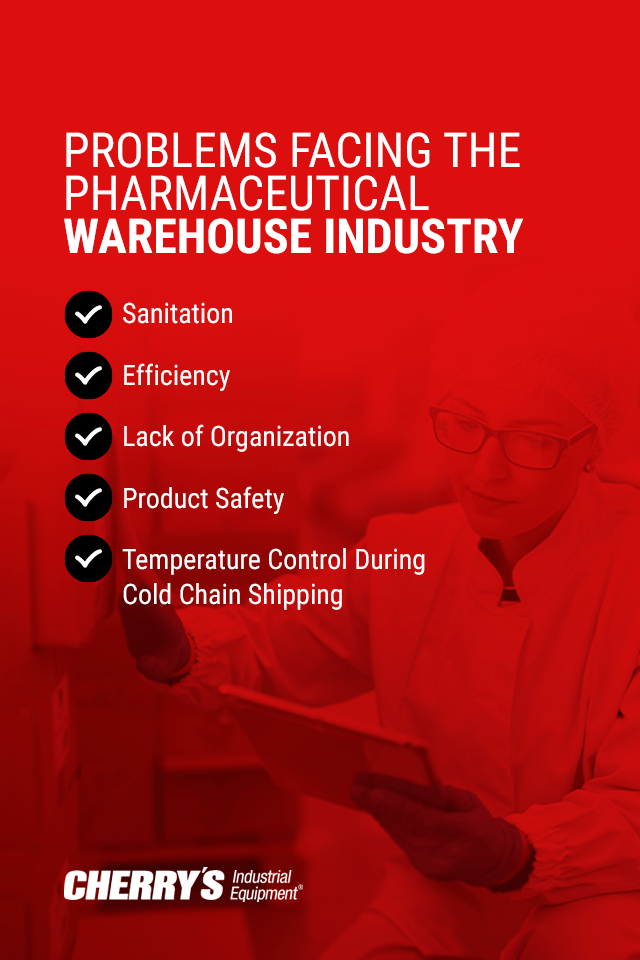
These are the five most common problems with pharmaceutical warehouse procedures:
1. Sanitation
All pharmaceutical companies are required to follow the Current Good Manufacturing Practices (CGMP) decided and regulated by the Food and Drug Administration (FDA). These rules for shipping pharmaceuticals ensure proper sanitary practices are followed, which protects the quality and potency of a drug — and ultimately, consumers’ health.
An inspection violation can shut down a pharmaceutical warehouse until the issue is resolved, which will considerably decrease the warehouse’s productivity. Further failure to comply with the FDA standards may result in the closure of a pharmaceutical warehouse.
2. Efficiency
With the global demand for pharmaceuticals steadily on the rise, pharmaceutical warehouses need to be more efficient than ever to keep up with the rapidly growing market. This means that pharmaceutical warehouses must set up efficient handling systems to expedite production and shipment. Speeding up their processes will help them stay ahead of generic drug competitors.
To achieve greater efficiency, pharmaceutical warehouses should seek to automate their material handling processes wherever possible. Keeping automation and equipment up to date will help boost overall productivity.
3. Lack of Organization
The first step to greater efficiency is good warehouse leadership that can effectively streamline operations. Poor pharmaceutical warehouse management can lead to unnecessary inefficiency issues and product loss, such as material spillage, that reduce productivity and profit. Clear communication and coordination throughout warehouse processes is essential to a smooth shipment.
4. Product Safety
When dealing with pharmaceutical products, one of the biggest concerns is always maintaining product integrity and delivering a safe product for consumer use. Mishandling the product at any point in the manufacturing or shipping process can cause the drug to degrade and lose its effectiveness. Degradation can detract from the product’s quality and potentially harm the rest of a batch by creating dust contamination.
To avoid product degradation, pharmaceutical warehouses should have separate areas of operation for handling and storing products to reduce constant particle-to-particle contact. Practicing proper product separation can also spare goods from potential cross-contamination issues.
5. Temperature Control During Cold Chain Shipping
In general, most pharmaceutical products need to be stored at a specific temperature while being transported from the warehouse to their ultimate destination. If not stored at the correct temperature, some pharmaceutical products degenerate, making them no longer useful to the patients who need them. Pharmaceutical warehouse profits also take a hit when they lose drugs to temperature blunders and ineffectiveness.
To prevent this product loss, temperature control measures must be employed to preserve the drugs throughout delivery. Cold chain shipping is a common way to keep product temperatures under control and ensure a safe delivery. The following section will further explore how cold chain shipping works and how to store pharmaceutical products.
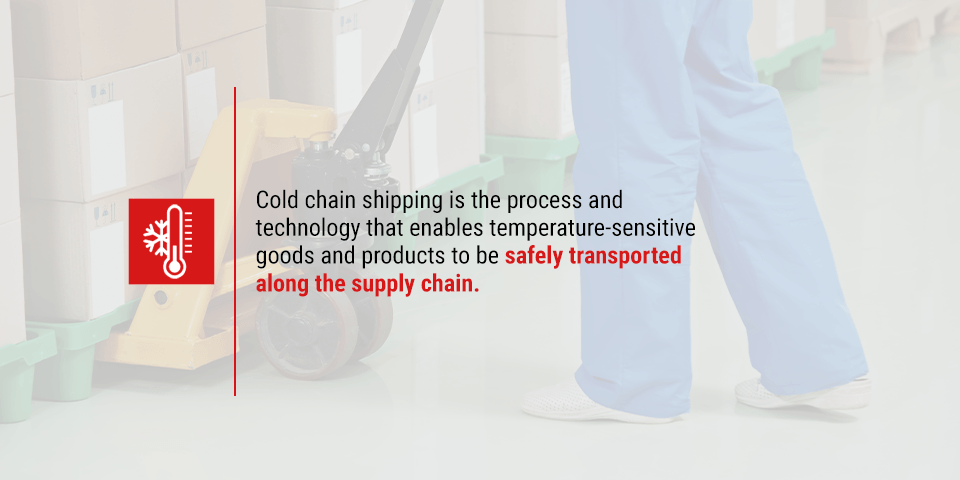
What Is Cold Chain Shipping?
Cold chain shipping is the process and technology that enables temperature-sensitive goods and products to be safely transported along the supply chain. Because storing certain products at a particular temperature is critical to preserving them, cold chain shipping heavily relies on science to evaluate and accommodate for the connection between perishability and temperature.
Any product that may be considered perishable will most likely need cold chain shipping to ensure its freshness. Perishable items can range from medical supplies and pharmaceuticals to temperature-sensitive foods like meat and seafood. All perishable products share the common characteristic of needing to be kept in certain conditions to be used safely and effectively by consumers.
Although no grocery store would sell unrefrigerated meat, billions of dollars worth of pharmaceutical products across the globe are stored and shipped at the wrong temperatures. Improper temperature incidents can make some drugs ineffective, harmful or even life-threatening to patients. While pharmaceutical companies are aware of these possibilities, keeping products at a stable temperature throughout processing is not always an easy fix.
Cold chain logistics includes multiple moving parts that must all work in tandem to preserve a product. Each of these five key elements must be considered when implementing cold chain solutions:
- Cold storage: Before a pharmaceutical product can even be shipped, it must be stored at the right temperature while it awaits transport.
- Cooling systems: Cooling systems can bring products up to the appropriate temperature and keep them there throughout each step of the supply chain, including processing, storing and transporting.
- Cold transport: While in transit, perishable products must remain at a stable temperature and consistent humidity levels.
- Cold processing: Pharmaceutical products must be processed in facilities that uphold both the proper temperature and sanitary standards.
- Cold distribution: Consolidating and deconsolidating loads for distribution, usually by using boxes, crates or pallets, must maintain temperature control.
Many federal regulators, such as the FDA, the Department of Transportation (DOT), the International Air Transport Association (IATA), the Transportation Security Administration (TSA) and U.S. Customs, have set requirements that cold chain logistics must adhere to. These standards have been put in place to make sure products are shipped and delivered safely.
The five most important regulatory factors are as follows:
- Product stability
- Packaging
- Transportation
- Monitoring
- Temperature minimums
Each federal organization has determined its own guidelines for various products regarding temperature, timing and packaging. In addition to the federal industry regulations set by major institutions, private sector shipping companies may also have their own individual list of quality standards.
Damages of Pharmaceutical Product Loss
Pharmaceutical products that require cold chain shipping are vulnerable to improper temperatures at every stage of the distribution process. Whenever drugs are not properly stored, packaged or shipped, they can incur damages that could cause harm to both patients and the pharmaceutical company they came from.
Delivering spoiled or low-quality products can result in lawsuits, public relations issues, a tainted reputation and distrust among shareholders for the pharmaceutical company responsible. Naturally, issues of negative brand recognition and product loss can drastically shake investor confidence, which can have a significant financial impact on a pharmaceutical company.
This level of product loss can easily stem from cold supply chain management issues. To avoid cold chain shipping loss in pharmaceuticals, industry leaders must pay careful attention to these five factors:
- Cold chain shipping training: Because the difference between a couple of degrees typically isn’t noticeable, employees must be thoroughly trained to recognize when temperature adjustments need to be made to protect delicate pharmaceuticals. All employees involved in cold chain shipping must be aware of the proper protocols for the operations to be successful.
- Employee accountability: Similar to adequate training, proper accountability measures must be practiced to ensure every pharmaceutical warehouse employee follows the appropriate cold chain shipping protocols at all times.
- Disrupted temperature: Of course, temperature variation is a primary problem for cold chain logistics. Limiting multiple deliveries, properly pre-cooling, promptly replacing faulty cooling devices and avoiding extreme weather conditions when possible can all cut down on product loss.
- Transport delays: When dealing with cold shipping, transport delays can be detrimental to maintaining product temperature. Proper packaging can help prevent contamination and regulate airflow over extended amounts of time.
- Other variables: Along with temperature, other factors such as moisture content should be monitored throughout the cold chain shipping process. Pharmaceutical companies could save themselves from unneeded product losses by monitoring humidity as well as temperature.
Although these are five of the most common reasons for pharmaceutical product damage, the most significant losses often result from a combination of these factors. To eradicate these problems, pharmaceutical warehouses need to adopt protocols and tools that allow for enhanced product protection. The next section will delve deeper into what these possible cold chain shipping solutions are and how to minimize pharmaceutical product damage.
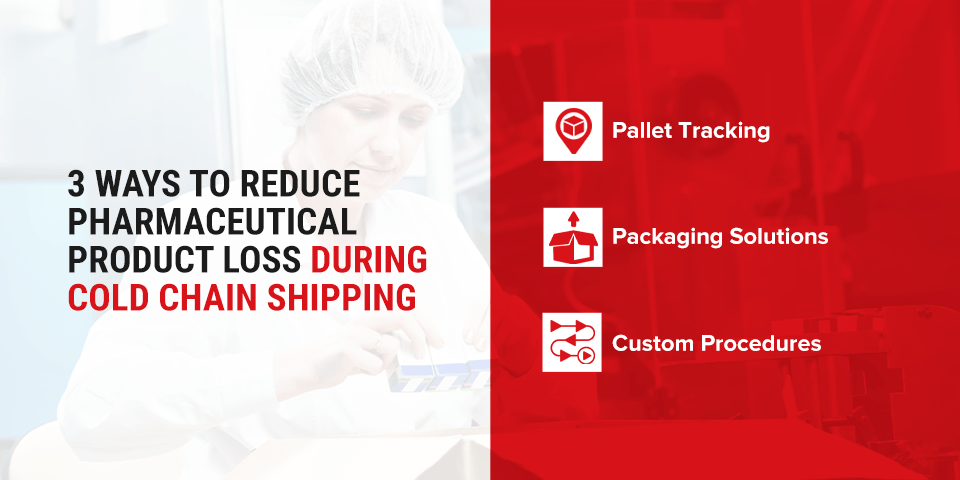
3 Ways to Reduce Pharmaceutical Product Loss During Cold Chain Shipping
Thanks to breakthroughs in tracking and monitoring technology, packaging innovations, warehouse upgrades and shipping and transportation improvements, there has been continual progress in pharmaceutical cold chain shipping procedures. Bioscience researchers are even examining drug manufacturing at the molecular level to discover more temperature-control answers.
As of now, these are three of the best methods to ensure safe cold chain shipping:
1. Pallet Tracking
One of the best ways to monitor and correct temperature variations is pallet tracking. Pallet tracking allows for monitoring platforms as they progress through the supply chain, which enables managers to spot more opportunities for improvement and increase accountability among workers.
Pallet tracking within warehouses is based on a radio-frequency identification (RFID) tracking system. RFID is preferable to the traditional pallet barcode method because it makes it easier to capture information while allowing for greater information storage. By simply using an RFID reader, pallet information, along with specific handling instructions and extra details, can be easily scanned and stored in a warehouse managing system. Logging the time of each scan will also help managers pinpoint any significant lapses in the process.
An essential accessory to an RFID tracking system’s success is plastic pallets. Durable plastic pallets provide a reliable anchor for RFID tags to be securely embedded in with no worry of whether the tags will fall off or get left behind on a broken pallet. Plastic pallets are also nonporous, unlike wood pallets, which means plastic models don’t absorb condensation or grow mildew as they transition in and out of temperature zones.
Additionally, plastic pallets are also easy to sanitize after each use with a pallet washer, which will protect products from contaminants like bacteria, dust, dirt and allergens. In this way, plastic pallets can protect your pharmaceutical warehouse from product loss in multiple ways.
Plastic pallets can also boost a pharmaceutical warehouse’s productivity when used in tandem with industrial pallet dispensers for easy transport and product loading. For any pharmaceutical warehouse layout, taking advantage of all the benefits plastic pallets offer will greatly enhance the cold chain shipping process.
2. Packaging Solutions
Effectively controlling a product’s temperature throughout cold chain shipping often comes down to packaging procedures. Various packaging materials will keep items at a stable temperature no matter the surrounding conditions. Using these tools can help preserve a product through the entire shipping process.
These are five of the most common technologies used for cold chain packaging:
- Gel packs: Pharmaceutical and medical shipments often use gel packs to keep products cool because the packs can be frozen solid or refrigerated to take on a more flexible form.
- Eutectic plates: Also known as cold plates, eutectic plates are similar to gel packs but can be reused many times.
- Dry ice: Because dry ice sublimates instead of melting when it comes in contact with the air, it is a convenient material for packaging. Primarily used for pharmaceuticals and food, dry ice can keep products frozen for short amounts of time.
- Liquid nitrogen: As an extremely cold substance, liquid nitrogen is typically used to keep packages frozen for long periods, especially biological cargo.
- Quilts: Using insulated quilts to wrap products can help ensure they stay frozen for a longer time span.
After properly putting products through the processing and packaging stages, pharmaceutical warehouses can use stretch wrappers and other wrapping equipment to protect the finished package as it waits to be shipped. Specifically, robotic stretch wrappers can automate the wrapping phase to speed up the process and boost productivity.
3. Custom Procedures
The best practices for pharmaceutical warehouse cold chain shipping may vary depending on the types of drugs being shipped and the environmental conditions. Some pharmaceutical warehouses may require custom solutions to help them move through the cold chain shipping process as efficiently and safely as possible.
Because cold chain pharmaceutical products tend to be time-sensitive and likely subjected to more inspection, a custom-engineered solution may be necessary to ensure a smooth delivery. Using equipment designed especially to manage temperature control or facilitate cold chain shipping more quickly could save a pharmaceutical warehouse from avoidable product losses.
Additionally, knowing how to navigate different customs requirements across borders is crucial to establishing a dependable international cold chain shipping system. With different countries following different customs guidelines, a pharmaceutical warehouse that ships internationally may need specific custom pieces of equipment to assist with cold chain shipping.
Trust Cherry’s Industrial Equipment to Provide You With the Equipment You Need to Minimize Product Loss
If your pharmaceutical warehouse handles temperature-sensitive products, use high-quality cold chain shipping equipment from Cherry’s Industrial Equipment to help you transport them. With more than 35 years of experience in the industry, Cherry’s Industrial Equipment has the necessary knowledge and expertise to get your pharmaceutical warehouse the equipment it needs to function at its highest level.
Because each pharmaceutical warehouse has different cold chain shipping needs, it can be difficult to know what equipment to purchase from a big box store. Instead of spending hours searching for the right equipment for your warehouse, let the expert staff at Cherry’s Industrial Equipment help you find exactly what you need — quickly and stress-free.
Learn how we can enhance your pharmaceutical warehouse by contacting Cherry’s Industrial Equipment today for a complimentary custom product quote and consultation.
